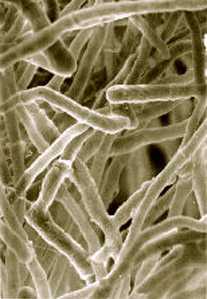Trichoderma reesei
| Trichoderma reesei | |
|---|---|
 | |
| Scientific classification | |
| Kingdom: | Fungi |
| Division: | Ascomycota |
| Subdivision: | Pezizomycotina |
| Class: | Sordariomycetes |
| Order: | Hypocreales |
| Family: | Hypocreaceae |
| Genus: | Trichoderma |
| Species: | T. reesei |
| Binomial name | |
| Trichoderma reesei | |
Trichoderma reesei is a mesophilic and filamentous fungus. It is an anamorph of the fungus Hypocrea jecorina. T. reesei has the capacity to secrete large amounts of cellulolytic enzymes (cellulases and hemicellulases). Microbial cellulases have industrial application in the conversion of cellulose, a major component of plant biomass, into glucose.[1]
T. reesei isolate QM6a was originally isolated from the Solomon Islands during World War II because of its degradation of canvas and garments of the US army.[2] All strains currently used in biotechnology and basic research were derived from this one isolate.[2]
Recent advances in the biochemistry of cellulase enzymology, the mechanism of cellulose hydrolysis (cellulolysis), strain improvement, molecular cloning and process engineering are bringing T. reesei cellulases closer to being a commercially viable route to cellulose hydrolysis.[3] Several industrially useful strains have been developed and characterised, e.g. Rut-C30,[4] RL-P37 and MCG-80. The genome of this organism was released in 2008.[5] This organism also has a mating type dependent characterised sexual cycle.[2]
Sexual development
T. reesei QM6a has a MAT1-2 mating type locus. The opposite mating type MAT1-1, was recently found, thus proving that T. reesei is a heterothallic species.[2] After being regarded as asexual since its discovery more than 50 years ago, sexual reproduction can now be induced in T. reesei QM6a leading to formation of fertilized stromata and mature ascospores.[2]
See also
- Cellobiohydrolase (CBH)
- Cellulosic ethanol
- Endoglucanase (EG)
References
- ↑ Kumar R, Singh S, Singh OV (May 2008). "Bioconversion of lignocellulosic biomass: biochemical and molecular perspectives". J. Ind. Microbiol. Biotechnol. 35 (5): 377–91. doi:10.1007/s10295-008-0327-8. PMID 18338189.
- ↑ 2.0 2.1 2.2 2.3 2.4 [Seidl V, Seibel C, Kubicek CP, Schmoll M. (2009). "Sexual development in the industrial workhorse Trichoderma reesei". PNAS 106 (33): 13909–13914. doi:10.1073/pnas.0904936106. PMC 2728994. PMID 19667182.
- ↑ Viikari L, Alapuranen M, Puranen T, Vehmaanperä J, Siika-Aho M (2007). "Thermostable enzymes in lignocellulose hydrolysis". Adv. Biochem. Eng. Biotechnol. 108: 121–45. doi:10.1007/10_2007_065. PMID 17589813.
- ↑ [Seidl V, Gamauf C, Druzhinina IS, Seiboth B, Hartl L, Kubicek CP (2008). "The Hypocrea jecorina (Trichoderma reesei) hypercellulolytic mutant RUT C30 lacks an 85 kb (29 gene-encoding) region of the wild-type genome". BMC Genomics 9: 327. doi:10.1186/1471-2164-9-327. PMC 2483294. PMID 18620557.
- ↑ Martinez D, Berka RM, Henrissat B et al. (May 2008). "Genome sequencing and analysis of the biomass-degrading fungus Trichoderma reesei (syn. Hypocrea jecorina)". Nat. Biotechnol. 26 (5): 553–60. doi:10.1038/nbt1403. PMID 18454138.
External links
- Risk Assessment Summary, CEPA 1999. Trichoderma reesei 1391A
- Risk Assessment Summary, CEPA 1999. Trichoderma reesei P59G
- Risk Assessment Summary, CEPA 1999. Trichoderma reesei P210A
- Risk Assessment Summary, CEPA 1999. Trichoderma reesei P345A
- http://www.eere.energy.gov/cleancities/progs/afdc/vwbs2.cgi?200
- Trichoderma spp.
- from genencor DNA sequence and Trichoderma reesei EST Database and Mitochondrial Genome.
- Nidetzky B, Steiner W, Claeyssens M (November 1994). "Cellulose hydrolysis by the cellulases from Trichoderma reesei: adsorptions of two cellobiohydrolases, two endocellulases and their core proteins on filter paper and their relation to hydrolysis". Biochem. J. 303 (Pt 3): 817–23. PMC 1137620. PMID 7980450.
- Miettinen-Oinonen A, Suominen P (August 2002). "Enhanced production of Trichoderma reesei endoglucanases and use of the new cellulase preparations in producing the stonewashed effect on denim fabric". Appl. Environ. Microbiol. 68 (8): 3956–64. doi:10.1128/AEM.68.8.3956-3964.2002. PMC 124001. PMID 12147496.
- CBH I from Trichoderma sp..
- CBH I from Trichoderma sp..
- Medve J, Ståhlberg J, Tjerneld F (November 1994). "Adsorption and synergism of cellobiohydrolase I and II of Trichoderma reesei during hydrolysis of microcrystalline cellulose". Biotechnol. Bioeng. 44 (9): 1064–73. doi:10.1002/bit.260440907. PMID 18623023.
![]() This article incorporates public domain material from websites or documents of the United States Department of Energy.
This article incorporates public domain material from websites or documents of the United States Department of Energy.